 History
History  History
History  Creepy
Creepy 10 More Representations of Death from Myth, Legend, and Folktale
 Technology
Technology 10 Scientific Breakthroughs of 2025 That’ll Change Everything
 Our World
Our World 10 Ways Icelandic Culture Makes Other Countries Look Boring
 Misconceptions
Misconceptions 10 Common Misconceptions About the Victorian Era
 Mysteries
Mysteries 10 Strange Unexplained Mysteries of 2025
 Miscellaneous
Miscellaneous 10 of History’s Most Bell-Ringing Finishing Moves
 History
History 10 Great Escapes That Ended Right Back in Captivity
 Weird Stuff
Weird Stuff 10 Fascinating Things You Might Not Know About Spiders
 Food
Food 10 Everyday Foods You Didn’t Know Were Invented by the U.S. Military
 History
History 10 Most Influential Protests in Modern History
 Creepy
Creepy 10 More Representations of Death from Myth, Legend, and Folktale
 Technology
Technology 10 Scientific Breakthroughs of 2025 That’ll Change Everything
Who's Behind Listverse?

Jamie Frater
Head Editor
Jamie founded Listverse due to an insatiable desire to share fascinating, obscure, and bizarre facts. He has been a guest speaker on numerous national radio and television stations and is a five time published author.
More About Us Our World
Our World 10 Ways Icelandic Culture Makes Other Countries Look Boring
 Misconceptions
Misconceptions 10 Common Misconceptions About the Victorian Era
 Mysteries
Mysteries 10 Strange Unexplained Mysteries of 2025
 Miscellaneous
Miscellaneous 10 of History’s Most Bell-Ringing Finishing Moves
 History
History 10 Great Escapes That Ended Right Back in Captivity
 Weird Stuff
Weird Stuff 10 Fascinating Things You Might Not Know About Spiders
 Food
Food 10 Everyday Foods You Didn’t Know Were Invented by the U.S. Military
10 Animals That Have Figured Out Their Own Life Hacks
Although we may not have flying cars or Mars colonies yet, we definitely have some wild technology to help us with everyday stuff. We have phones and transportation and indoor plumbing, all things that would have blown our Founding Fathers’ minds.
Like us, our animal buddies have figured out ways to make their lives just a little easier. From cleaning to sleeping, here are 10 animals who can do things just a little better than us.
10 Crocodile Diving Hack

While we humans rely on submarines or scuba gear to get us to the depths of the ocean, crocodiles have figured out a much simpler way to do it. When these bad boys need to get to the ocean floor to catch dinner, they simply eat a few stones.
By swallowing big stones and rocks, they can increase their body weight and sink down to snag much bigger meals. This helps them with their deep-sea diving, their swimming abilities, and their digestion problems.[1]
The rocks line up in the crocodile’s stomach and grate the food to help break down any of the tougher-shelled prey that the crocodile eats. The extra weight from the stones also allows the crocs to travel farther down in the water for bigger, tastier prey.
9 Rhino Cleaning Hack
No need for showers or brushes. Rhinos have found a method to get another animal to do the work for them.
In the African savanna, rhinos become hosts for a lot of ticks, which cause problems with their sensitive skin. This is where the oxpeckers come in. These birds will perch on the rhinos’ backs and eat all the ticks as part of the birds’ blood-based diet.
Oxpeckers also act as useful safety tools or alarm systems.[2] Rhinos are shortsighted and often cannot see when predators are drawing near. However, the birds have a good view from a rhino’s back and emit a distress call to let the rhino know that something is coming. Not that the oxpecker is worried about the rhino, it just doesn’t want another animal to eat its ticks.
8 Chiton Dental Hack
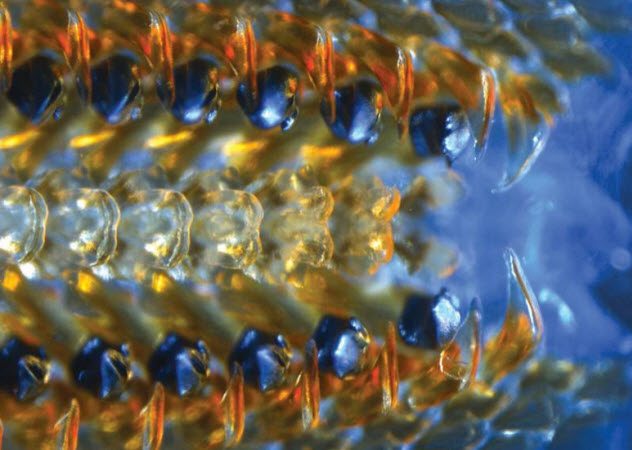
There is one animal in particular that beats our modern dental industry. The chiton, a marine mollusk that lives in the Gulf of Mexico, has the ability to grow the hardest teeth in the world.
These teeth are made out of magnetite, the hardest material produced by any organism, and are perfect for munching on the animal’s favorite algae snacks.
Scientists believe that humans will eventually be able to harness the power of the proteins that form the chitons’ teeth to “synthesize tough materials in labs.”[3] But for now, we can just marvel at their beautiful chompers.
7 Stick Insect Birth Hack

One animal that doesn’t need a man is the female stick insect. They are able to give birth through parthenogenesis, a method of procreation that doesn’t involve a mate. It is sometimes referred to as a “virgin birth.”
If well-fed, a female stick insect is able to lay unfertilized eggs all on her own, no mate required. Some scientists have reproduced this phenomenon in their own labs in hopes of applying this knowledge to human reproduction.[4]
But this asexual reproduction goes deeper for the insects. They really just don’t want to mate at all. In fact, female stick insects are so opposed to getting in the sack that they have developed an anti-aphrodisiac chemical which they can spray at any randy male to diminish the temptation.
6 Salmon Navigation Hack
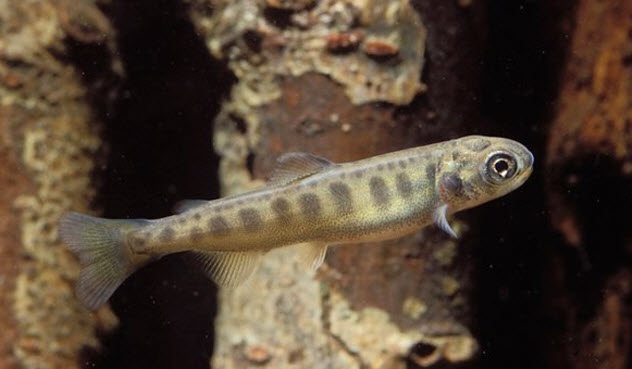
As much as we love to use Google Maps, salmon have figured out an even better way to get around town. These fish are born with the ability to sense variations in the Earth’s magnetic field. This skill allows them to navigate from fresh water to salt water so that they can eat and reproduce.[5]
Salmon are born in fresh water, travel to salt water, and then return to the stream where they were born to give birth. Other than their sense of magnetism, salmon use their sense of smell to navigate. The fish can recognize the smell of their birth stream, which helps them to find their way back home.
5 Black Swallower Eating Hack
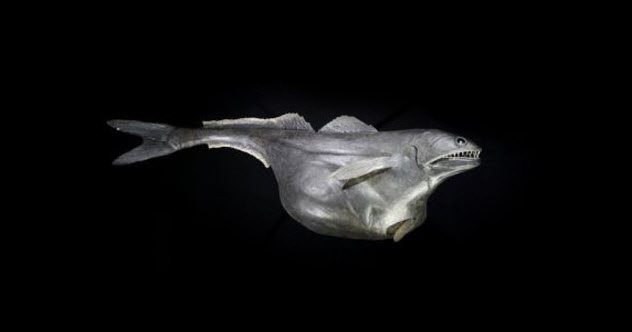
You know the saying “My eyes are bigger than my stomach”? Well, that doesn’t apply to the black swallower. At only 10 centimeters (4 in) long, these deep-sea swimmers may appear small, but they can eat prey more than two times their length and 10 times their mass.
Native to the waters of North America, black swallowers live as far as 3,000 meters (10,000 ft) below the ocean surface and run into a lot of large predators that would love nothing more than to get their grub on. Little do their predators know, the black swallowers are the ones that are going to eat dinner.
These little fish are equipped with razor-sharp teeth that can take their enemies down in one gulp. Due to the black swallower’s extending stomach, it can devour much bigger predators with just one bite.[6]
The black swallower’s stomach can stretch so far that the skin becomes transparent. Any prey that comes along may think that it’s going to have an easy snack, but it will soon find out that it probably shouldn’t have picked on the little guy.
4 Plumed Basilisk Walking Hack
The plumed basilisk has mastered a hack that only one famous being has ever been said to do: walk on water. Nicknamed the Jesus Christ lizard, this critter can use its little toes to cross bodies of water.
Plumed basilisks make their homes in the trees that you can find lining a body of water. When predators, such as birds, come down to eat them, the lizards will simply drop to the water below and run to safety.
The toes on their rear feet have skin-like scales. These expand when hitting liquid to increase the surface area of each foot that contacts the water. By quickly moving their toes, the lizards can create air pockets on the surface of the water that keep them from sinking.[7]
3 Dolphin Sleeping Hack

Have you ever needed to stay awake to study for a big exam but just couldn’t keep your eyes open? Well, dolphins don’t need to worry about that. These marine mammals can stay awake for 15 days at a time by sleeping with half of their brain.
Known as unihemispheric sleep, this phenomenon allows the dolphins to rest while staying alert to the never-ending risk of shark attacks. This trick also keeps dolphins from drowning. A full brain sleep in the ocean would put them in danger of dying because their breathing is a conscious function.
By keeping half of its brain asleep, a dolphin can rest but still go to the surface for air when needed.[8]
2 Frog Defense Hack
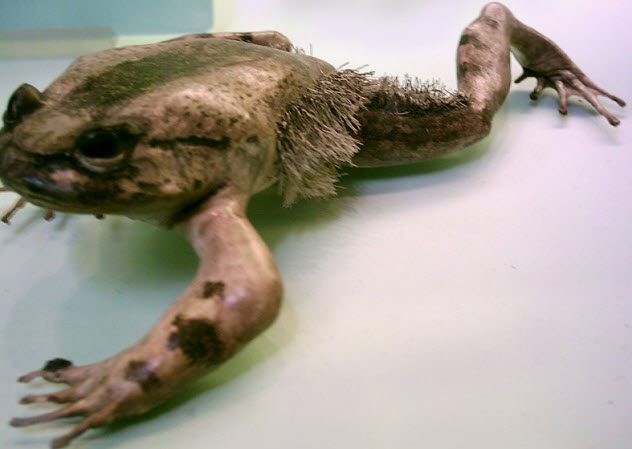
The Trichobatrachus robustus (aka the “hairy frog” due to the hairlike fibers found on the male’s skin) has the gross ability to break its own bones to fight off prey. When under attack, these frogs will quickly contract their muscles, snap the bones in their hind feet, and push the bones out of their skin to create protruding claws.
Due to the formation of collagen in the frog’s toe bones, it is possible for these creatures to break the tips of their toes and not their whole legs. This strange form of defense allows the hairy frogs to both fight off and completely terrify their prey.
It can be used against humans, too. In Cameroon, the frogs are hunted for food by the indigenous people. To avoid getting hurt by these froggy weapons, the hunters have to use long spears to catch these creatures.[9]
1 Millipede Poison Hack
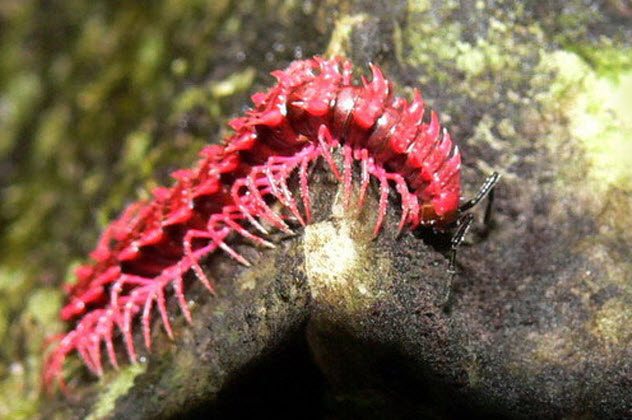
Another method of attack in the animal kingdom involves the production of hydrogen cyanide in dragon millipedes.
Despite their hundreds of legs, millipedes aren’t the best at outrunning their predators. In their natural habitats, millipedes have to worry about becoming food for a variety of other animals, including ants, amphibians, beetles, birds, mammals, reptiles, slugs, and spiders.
With danger around every corner, these leggy creatures have their own hack to ward off enemies. When attacked, dragon millipedes can either secrete a deadly form of hydrogen cyanide from their pores or spray their attackers from up to 50 centimeters (20 in) away.[10]
The predators are no match for the cyanide as the millipede’s form of the chemical is 18 times the lethal dose for a common pigeon. A good spray will give their predators a nasty shock when they go in for a bite.
Estelle Cooper is a film student in New York City and can tell you almost anything you need to know about Dwayne “The Rock” Johnson.
For more amazing stories about animals, check out 10 Amazing Ways Animals Are Superior To Man and Top 10 Incredible Ancient Animals.








